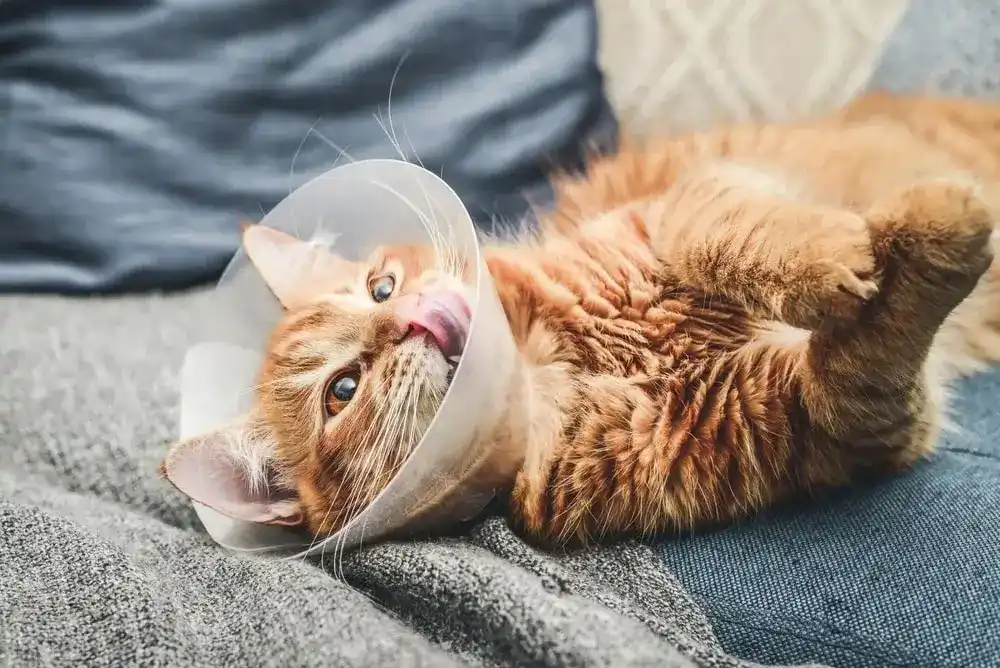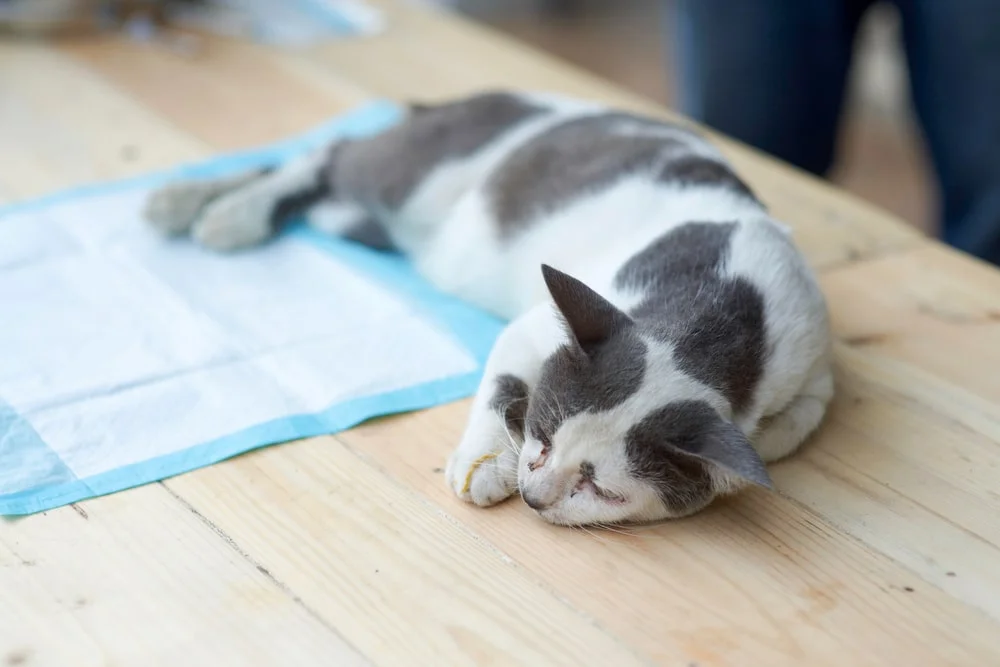PET HEALTH
Vet visits for cats can cost a lot of money, especially if your cat’s experiencing chronic urinary blockages. Eventually, your vet may offer surgery as a solution. Perineal urethrostomy (PU) surgery is a standard procedure performed on male cats with urinary obstructions.1 The surgery for female cats is called transpelvic urethrostomy (TPU).
PU surgery for cats can cost several thousand dollars, with pet parents paying $1,0002 on the lower end but typically closer to $3,000–$4,500.3 Our claims data has shown that our pet parents have been billed around $620–$3,900 for a urinary obstruction exam and treatment on their male cats, which may include surgery.4
It’s a lot of money, so it’s important to figure out when it’s necessary. Let’s dive into what PU surgery is, when it’s recommended, what to expect from the procedure, and how pet insurance may reimburse the vet bill.
What Is a Perineal Urethrostomy (PU)?
PU surgery removes the narrowest part of the cat’s urethra — a tube that transports urine from the bladder.1 The goal of this surgery is to create a new opening and shorten the urethra. After the surgery, urine obstructions are less likely to occur, and if they do occur, they can pass easier.
House cats are prone to developing obstructions for a variety of reasons, including lack of exercise and dehydration.1 These issues can cause blockages — like kidney stones or mucus — that get stuck in the urethra. If left untreated, urinary obstructions can be life-threatening.
Male cats are likely to experience chronic issues due to their anatomy. Their urethra is slightly longer and narrows at the exit. Female cats have a shorter urethra with a consistent diameter.
When Is PU Surgery Recommended for Cats?
Surgery is commonly recommended for male cats with urinary obstructions when other treatments have failed. Before going the surgical route, vets may treat urinary obstructions by using a catheter, which is pushed through the urethra and into the bladder. Then, a solution is used to flush the stones or mucus. Afterward, your cat may be prescribed antibiotics or other medications.
However, there’s a limited number of times a vet can take this route before they offer surgery. PU surgery can provide your cat with long-term relief from symptoms of urinary tract diseases, like:5
- Straining to pee
- Blood in the urine
- Painful urination
- Inappropriate urination
- Inflammation
- Secondary infections
Another reason a vet may offer PU surgery is if your cat has repeated obstructions or severe symptoms. Bouts of obstructions can resolve themselves within 5 days, but many cats have multiple episodes within 6 months to 1 year.5 In severe cases, cats may cry, become restless, or retreat from normal life. Complete urine obstruction can lead to death in 3–6 days.5
Urinary Blockages May Hurt Your Cat and Your Wallet
Cat PU Surgery: Cost and Alternatives
Treating a cat urinary blockage can cost a lot. According to our data, MetLife Pet Insurance’s pet parents were billed between $620 and $3,900 for urinary obstruction exams and treatments for their male cats.4
There may be additional costs, like:5
- Diagnostics
- Physical exams
- Prescription medications
- Speciality food
- Hospitalization
- Follow-up visits
Your final bill can depend on where you live and your chosen vet. Pet parents should work with their vet for a complete quote to prepare accordingly.
Are there alternatives to PU surgery for cats?
While alternatives aren’t as effective as PU surgery, the best way to prevent your cat from needing PU surgery is by taking measures to prevent urinary obstructions.6 Here are a few things you can do:
- Make sure your cat has fresh, running water and quality wet food.
- Enrich your cat’s environment with plenty of scratching posts.
- Play with your cat more often.
- Address any potential litter box issues (e.g., type of litter).
- Keep up with regular wellness visits.
Keep in mind that cats who develop urinary obstructions may have repeat episodes, leading to more money spent on vet visits and medications.1 PU surgery could be a way to help give cats long-term relief so they can live long, healthy lives.7
What Should I Expect From Cat PU Surgery?
First, your cat may have a pre-surgery exam and bloodwork. This can help the team determine your kitty’s health status and which anesthesia they need. They may also offer intravenous (IV) fluids to correct any dehydration and electrolyte imbalances caused by the obstruction. This can help decrease the likelihood of post-surgery complications.1
During surgery, your cat may be placed under general anesthesia. Then, their stomach may be shaved to prep the surgical site.1 Finally, the vet might create a new urinary opening for your cat by removing the penis and suturing the larger part of the urethra to the skin.1
PU surgery takes about 1–2 hours to complete, and your cat will likely stay in the hospital for 1–2 days total. During this time, the vet may place a urethral catheter, monitor your cat’s urination, check on the incision site, and administer any IV fluids and pain medications.8
What’s cat PU surgery recovery like?
Cats must wear an Elizabethan collar (e-collar) or bodysuit for at least 2 weeks to prevent licking and biting.1,8 Pet parents should work with their vet for ways to keep their cat calm and restrict activity while they’re home.
Try your best to keep your pet in a small, confined area where you can keep an eye on them. Your vet may send you home with special litter made from shredded paper.1 Traditional litter can stick to their incisions and lead to infections.
You should expect your kitty to have bloody urine and occasional accidents outside the litter box.8 Keep a washcloth on hand to clean their fur, as they may have trouble grooming themselves.
Is my cat at-risk for complications after PU surgery?
Your cat is unlikely to develop serious complications after surgery, but post-op complications that require a trip to the vet can include:6,8
- Straining to pee with no urine passed in more than 6 hours
- Vocalization while straining to pee
- Severe lethargy
- Vomiting
If your cat experiences diarrhea or constipation, you should contact your vet to discuss your options, though both can be a side effect of the anesthesia.
While it’s possible for your cat to form stones too large to pass through the new urethrostomy opening, most cats do not develop obstructions after PU surgery. As a result, the prognosis after surgery is typically good.
Stressed About Perineal Urethrostomy Costs? Pet Insurance Can Help
PU surgery for cats can reduce the amount of pain and discomfort in your pet’s life, but it can be expensive. That’s where pet insurance can help. Take Cosmo, for instance. This 4-year-old domestic medium hair cat was treated for a urinary obstruction in Seattle. His parents paid about $3,300 to their vet, but with cat insurance, they got almost $3,000 back in their pocket.4
MetLife Pet Insurance can help pet parents pay for those expensive treatments cats like Cosmo might not otherwise get. Signing up is quick and easy, so you can get back to what matters: time with your feline friend.


